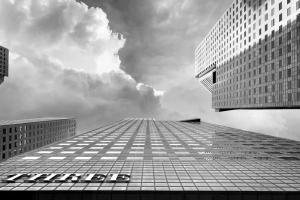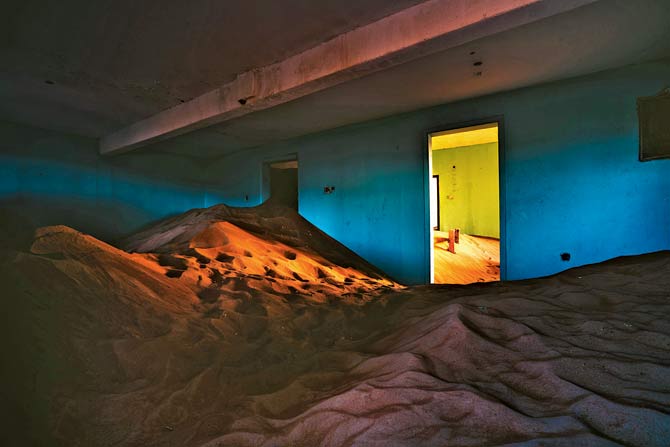Photographer Salamat Husain discusses the politics of being "allowed" access into spaces, while reminding us of the value of slowing down in a digitised world

The Uprising, Singapore
 This week, the Nine Fish Gallery and Dot Line Space will host a posse of shutterbugs, including Mumbai's news photographers, at a show titled, Not Allowed, by photographer Salamat Husain, 37. The guests, some of whom are used to being prevented from practising photography/videography in public-private spaces, will be encouraged to share their perspective on the 45-odd images in the solo exhibition. They can narrate their stories—disrupted shoots, stealthy entries into no-photography zones, confiscation of equipment—which, Husain hopes, will add newer perspectives to his exploration of contemporary society through photography. CM Uddhav Thackeray, also a passionate photographer, has been invited as chief guest, though one is not sure if his Tuesday diary will allow the commitment.
This week, the Nine Fish Gallery and Dot Line Space will host a posse of shutterbugs, including Mumbai's news photographers, at a show titled, Not Allowed, by photographer Salamat Husain, 37. The guests, some of whom are used to being prevented from practising photography/videography in public-private spaces, will be encouraged to share their perspective on the 45-odd images in the solo exhibition. They can narrate their stories—disrupted shoots, stealthy entries into no-photography zones, confiscation of equipment—which, Husain hopes, will add newer perspectives to his exploration of contemporary society through photography. CM Uddhav Thackeray, also a passionate photographer, has been invited as chief guest, though one is not sure if his Tuesday diary will allow the commitment.
"Two words, 'photography' and 'prohibited', bring so many common experiences to the fore, more so for the paparazzi whose trade entails recording the moment for posterity," says Gourmani Das, 27, show curator and director of the gallery. He is keen to start a dialogue around spaces—sacred, secular, public, restricted and open. Das, whose tryst with the city began from the BFA classroom at the Sir JJ School of Art, has devoted a year to deliberate with Husain over the possibilities of the Not Allowed concept. Long afternoons over coffee and deep exchanges over the complex role of photography as an art form, much like paintings, brought the two together. "Who else but a migrant Bengali from Tripura could have appreciated the Not Allowed vibe?" says Das of himself. Once based in Agartala, he in jest, refers to the "mainland vs native place" construct that people from India's North Eastern states relate to.

Salamat Husain's new exhibition, Not Allowed, opens at Nine Fish Art Gallery, Byculla, on Tuesday. Pic/ Ashish Raje
Husain's works are, however, not strictly about a political confrontation or crisis regarding space. The show title is in sync with India's current political-social climate in which boundaries of public and private spaces are being contested. But, as Husain elaborates, Not Allowed is a larger metaphysical inquiry into the concept of space, not necessarily through the prism of news photography. "It is not directed against an authority, but is about how a 'Not Allowed' notification affects vision and thoughts,
sets off an inner reaction, just as it has done in my case." Husain recalls security restrictions he encountered in spaces as varied as the synagogue at Kala Ghoda, a shipment container site in Dubai, and even the humble Churchgate station a few years ago.
Not Allowed also draws attention to large vistas, panoramic shots, geographical wonders for which we do not have much time in a digitised world. "Distances have become shorter; lives are faster and personal spaces are compromised upon. We don't have the time to enjoy our surroundings. I want to remind our generation of the outdoor beauty that the earlier generation cared for and thrived on." As an artiste, he is worried about the increasing importance attached to screen space.

Ghost Town Series, Sharjah, UAE
Husain's reflection on spaces coincidentally echoes in his choice of a relatively new gallery, situated in an erstwhile textile mill on Dr Ambedkar Road. The vintage value adds sparkle to Husain's showcase, mostly stemming from travel, over the past four years. The photos—shot with a smartphone, digital camera, and drones—emerge from places like Vik, El Nido Palawan, Beijing, Sydney, London and Dubai. Shuttling between Dubai (second home because of shoot assignments) and Mumbai (birthplace), Husain's last solo was at Gallery 7 in Kala Ghoda back in 2014.
His current exhibition, which he calls restless, is an amalgamation of mediums, divided in three categories—Way Too Close, Double Exposure and Minimalism. The three aspects represent thoughts at various points in time, especially the parallel constructs of Double Exposure. The works (some framed, some left uncaged, captioned) do not have a direct literal connect with the show title, but at the center of the show lies the experience of a photographer. The juxtaposition of the images of varying sizes (averages to 12 x 14 inch) is designed to evoke interest in the slice of life portrayed.

Dimensions—Grampians National Park, Victoria, Australia
While Mumbai-centric images do not feature in Not Allowed, Mumbai is an unmistakable part of the photographer's makeup. Even though his grandfather, the legendary painter-poet-filmmaker MF Husain is no more, Husain lives in the same Cuffe Parade residence where poets, literateurs, Bollywood personalities congregated to listen to India's highest-paid and most respected artist. Just as the house symbolises appreciation of fine art and intellectual exchanges, it reminds him of the time when it was ransacked in protest of an "obscene" lithograph of Lord Hanuman and Goddess Sita. Husain has witnessed a momentous passage of time, although he has been in Mumbai intermittently. He schooled at Krishnamurti Foundation School Rishi Valley, later attended Mumbai's HR College and then moved to the United States for a graduation degree in animation and graphic design, followed by further initiation in the Hallmark Institute of Photography, Massachusetts. But Mumbai, remained the focal point during all phases. He has vivid recollections of visiting the sets of the films made by "Dada", where he met Madhuri Dixit and Tabu. Dada's love for Urdu and languages also impacted the family, as it often shows when Husain quotes Khalil Gibran in the photo captions. At 16, he had assisted Dada on the sets of Gajagamini. Since the iconic artist remains an inseparable part of Husain's work, curator Das had consciously decided to view each photograph in the Not Allowed series as a visual entity in itself—devoid of the artist's legacy, and devoid of any political positioning within the world of photography.
In an age where every smartphone user is a travel photographer, Husain's images bring an unusual tautness and grandeur to the otherwise routinely captured vistas. His landscape photography has an expansive scale in which humans appear as tiny flecks in the cosmos—whether on the beaches of Sydney or at the Vandri lake nearing the Maharashtra-Gujarat border.
Sumedha Raikar-Mhatre is a culture columnist in search of the sub-text. You can reach her at sumedha.raikar@mid-day.com
Catch up on all the latest Mumbai news, crime news, current affairs, and also a complete guide on Mumbai from food to things to do and events across the city here. Also download the new mid-day Android and iOS apps to get latest updates
 Subscribe today by clicking the link and stay updated with the latest news!" Click here!
Subscribe today by clicking the link and stay updated with the latest news!" Click here!









